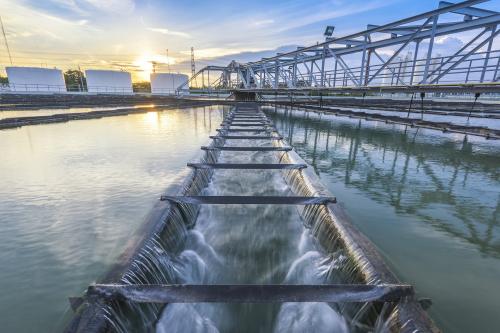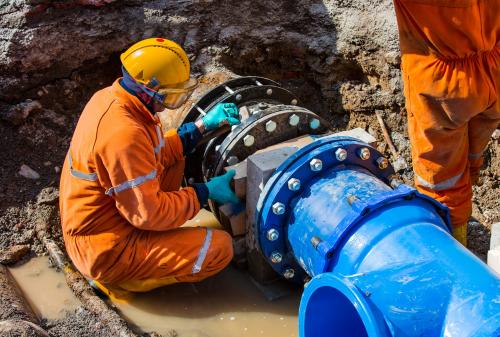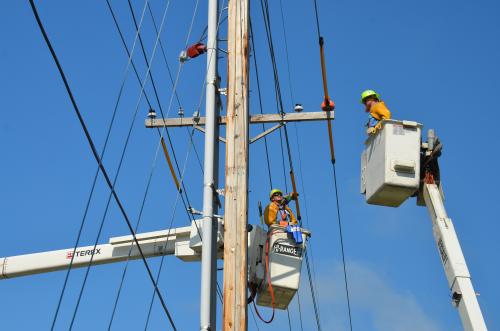This post is the third in a series examining how local leaders across the U.S., including utilities and other community groups, are accelerating efforts toward identifying, hiring, training, and retaining the future water workforce—a segment of the labor force seeing a rise in retirements and struggling to fill jobs, even though these positions offer clear pathways to economic opportunity.
Falling into disrepair and neglect, the country’s water infrastructure is posing an enormous physical and financial challenge for many regions. However, many of these same regions are launching new plans and investments to accelerate infrastructure repairs, which are often going hand-in-hand with larger economic development activities, including the support of long-lasting career pathways.
Indeed, from California’s Bay Area to Louisville, Kentucky, regional leaders are seizing the moment to not only improve their infrastructure, but also to improve their economies. With the aim to hire, train, and retain a skilled water workforce, water utilities and a range of community partners—from educators to labor groups—are connecting workers with greater economic opportunity. And it is the promise of this opportunity that is spurring new thinking and action, especially in municipalities like Camden, New Jersey, where poverty, joblessness, and environmental degradation have persisted for some time.
From California’s Bay Area to Louisville, Kentucky, regional leaders are seizing the moment to not only improve their infrastructure, but also to improve their economies.
While the city of Camden continues to face a long list of economic and environmental struggles, including a poverty rate over 38 percent, dozens of contaminated brownfields sites, and an older combined sewer system susceptible to flooding, leaders are pioneering collaborative solutions focused on infrastructure investment and workforce development. Led by the Camden County Municipal Utilities Authority (CCMUA), the region’s primary wastewater utility, a variety of groups have partnered together to improve existing water services, promote green infrastructure development, and help local residents fill positions connected to all these activities.
For example, the Camden Collaborative Initiative (CCI)—a partnership of more than 40 different community organizations and businesses—has served as a regional body and platform to define priorities, encourage discussion, and test out new ideas, with a focus on improving environmental and economic outcomes. CCMUA has served as a major partner and funder in CCI’s efforts, including the creation and coordination of seven different working groups, which focus on anything from environmental education to brownfields redevelopment. At a more basic level, since many of CCI’s activities are driven by non-profit partners who lack much extra financial capacity, CCMUA has also offered community meeting space and served in an advisory role to move efforts forward.
In particular, CCI’s activities have built off a number of ongoing workforce development initiatives, which have aimed to equip disadvantaged residents with the skills and job readiness they need to pursue careers in the trades, administration, and other positions in the water sector.
One such effort, PowerCorps Camden, has helped promote environmental stewardship and applied learning in the community. Modeled off a similar program in Philadelphia, the effort aims to recruit young people, ages 18 to 26, from the city of Camden to take on full-time positions in a six-month AmeriCorps program, where they help maintain green spaces and improve formerly polluted sites. Crucially, many of these “at-risk” youth may not be able to easily secure employment elsewhere, and they are also gaining additional life skills training and benefiting from job placement services. While the program is still nascent since it only started in 2015, it has long-term potential to boost training, reduce crime, and ultimately support stronger career pathways in the water sector, whether filling needs in utilities, engineering companies, or other local employers.
Likewise, in concert with other CCI partners, CCMUA has spearheaded a Green Jobs Summer Ambassadors Program, which represents a 5-week immersive experience for high school students aimed at introducing them to water-related careers. Similar to another effort pursued in Wilmington, Delaware, the program not only gives students the chance to engage in environmental management and conservation, but it also connects them with mentors and potential future employers. Even though the program just started, it has already reached dozens of students, who have helped support 50 different green spaces across the city, including rain garden maintenance, leading to several neighborhood benefits and more responsible stormwater management.
Together, the partners in CCI have helped CCMUA—and Camden as a whole—elevate and act on its water workforce needs. These efforts are also helping to address an ongoing workforce frustration for many utilities head-on: the desire to find replacement workers in local communities, which may be experiencing high unemployment, but the frequent need to look beyond these communities because residents do not have the skills or training needed to fill jobs. Meanwhile, utilities do not always have the capacity to address this frustration by themselves.
After all, CCMUA alone can only do so much financially and programmatically, since it employs just 130 workers and must balance a number of operational responsibilities. For example, CCMUA owns and operates one of the largest wastewater treatment plants in the Northeast—treating 58 million gallons of water each day. At the same time, it must oversee 135 miles of pipes in nearby Camden County. Yet, CCMUA does not actually own or operate pipes in the city of Camden itself; as a result, the Camden region deals with a fracturing of water oversight and responsibilities, similar to what many regions face nationally. In other words, it takes the efforts of CCMUA and many other partners to jointly—and often voluntarily—address these infrastructure and economic issues across the entire region.
And in a region with so many infrastructure and economic development concerns, the challenge can appear overwhelming. However, Camden’s struggles also open up opportunities for more nimble and creative experimentation. Without sustained and predictable financial support across different jurisdictions, CCMUA has forged collaborations in a more agile, cost-effective manner—by working with other employers, supporting smaller green infrastructure projects, and simply reaching out to the community. In turn, Camden has become a testbed for a variety of innovative projects, programs, and partnerships, all backed by a vision to collectively advance pathways to greater economic opportunity for residents in the local community.
To continue promoting these career pathways, though, it will take collaborative efforts like CCI—along with progressive leadership and sustained funding, likely at a state and national level—in support of long-term planning and experimentation. State Revolving Funds, for instance, have been a key financial tool for Camden to pursue green infrastructure and brownfields remediation projects. At the same time, heightening the visibility of regional efforts is key to gain community buy-in, and there remains a need to support an ongoing innovation and adaptation process across different places nationally. Not all regions, of course, have the capacity to take on these workforce development activities, but it would help if they had more consistent awareness of best practices and the channels by which they could learn from each other, which is where efforts in Camden should gain greater attention.
The Brookings Institution is committed to quality, independence, and impact.
We are supported by a diverse array of funders. In line with our values and policies, each Brookings publication represents the sole views of its author(s).







Commentary
The water workforce opportunity: How Camden is driving collaborative solutions around its infrastructure and economy
May 14, 2018